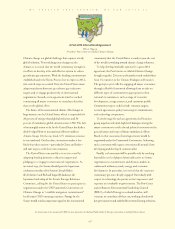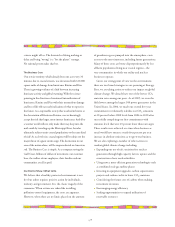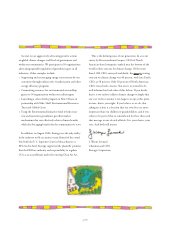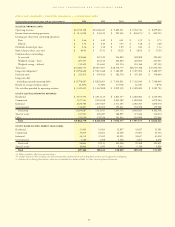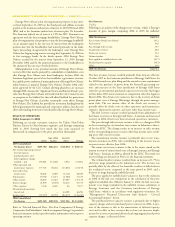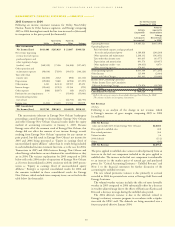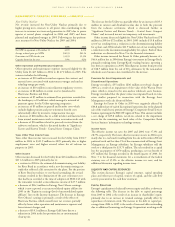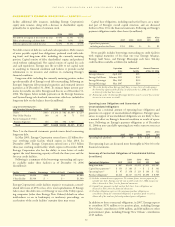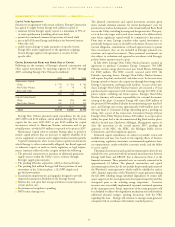Entergy 2006 Annual Report Download - page 42
Download and view the complete annual report
Please find page 42 of the 2006 Entergy annual report below. You can navigate through the pages in the report by either clicking on the pages listed below, or by using the keyword search tool below to find specific information within the annual report.
ENTERGY CORPORATION AND SUBSIDIARIES 2
2000066
26
Entergy operates primarily through two business segments: Utility
and Non-Utility Nuclear.
■UTILITY generates, transmits, distributes, and sells electric power in
a four-state service territory that includes portions of Arkansas,
Mississippi, Texas, and Louisiana, including the City of New
Orleans; and operates a small natural gas distribution business.
■NON-UTILITY NUCLEAR owns and operates five nuclear power plants
located in the northeastern United States and sells the electric
power produced by those plants primarily to wholesale customers.
This business also provides services to other nuclear power
plant owners.
In addition to its two primary, reportable, operating segments,
Entergy also operates the non-nuclear wholesale assets business. The
non-nuclear wholesale assets business sells to wholesale customers the
electric power produced by power plants that it owns while it focuses
on improving performance and exploring sales or restructuring
opportunities for its power plants. Such opportunities are evaluated
consistent with Entergy’s market-based point-of-view.
Following are the percentages of Entergy’s consolidated revenues
and net income generated by its operating segments and the percent-
age of total assets held by them:
% of Revenue
Segment 2006 2005 2004
Utility 84 84 84
Non-Utility Nuclear 14 14 14
Parent Company &
Other Business Segments 2 2 2
% of Net Income
Segment 2006 2005 2004
Utility 61 73 71
Non-Utility Nuclear 27 31 27
Parent Company &
Other Business Segments 12 (4) 2
% of Total Assets
Segment 2006 2005 2004
Utility 81 82 81
Non-Utility Nuclear 17 16 16
Parent Company &
Other Business Segments 2 2 3
HURRICANE KATRINA AND HURRICANE RITA
In August and September 2005, Hurricanes Katrina and Rita caused
catastrophic damage to large portions of the Utility’s service territory
in Louisiana, Mississippi, and Texas, including the effect of extensive
flooding that resulted from levee breaks in and around the greater
New Orleans area. The storms and flooding resulted in widespread
power outages, significant damage to electric distribution, transmis-
sion, and generation and gas infrastructure, and the loss of sales and
customers due to mandatory evacuations and the destruction of
homes and businesses. Total restoration costs through December 31,
2006 for the repair or replacement of the Utility’s electric and gas
facilities damaged by Hurricanes Katrina and Rita and for business
continuity are $1.48 billion (including $38 million of AFUDC). The
costs include $828 million in construction expenditures and $654
million recorded originally as regulatory assets. Entergy recorded reg-
ulatory assets in accordance with its accounting policies because
management believes that recovery of these prudently incurred costs
through some form of regulatory mechanism is probable, based on
historic treatment of such costs in the Utility’s service territories and
communications with local regulators. These costs do not include
other potential incremental losses, such as the inability to recover
fixed costs scheduled for recovery through base rates, which base rate
revenue was not received due to a loss of anticipated sales. For
instance, at Entergy New Orleans, the Utility operating company that
continues to experience a reduction in the level of cost recovery due
to lost customers caused by Hurricane Katrina, Entergy estimates that
lost net revenue due to Hurricane Katrina will total approximately
$194 million through 2007. In addition, Entergy estimates that the
hurricanes caused $38 million of uncollectible Utility customer
receivables. Entergy estimates that its additional storm restoration
spending, excluding Entergy New Orleans, will be approximately
$60 million.
Entergy New Orleans has spent approximately $188 million on
storm restoration through December 31, 2006, and estimates that it
will ultimately spend approximately $275 million. Entergy New
Orleans also incurred $22 million of uncollectible accounts receivable
because of Hurricane Katrina. The storm restoration cost estimate
includes approximately $80 million in spending for accelerated rebuild-
ing of the gas system in New Orleans that Entergy New Orleans expects
will be necessary due to massive salt water intrusion into the system
caused by the flooding in New Orleans. The salt water intrusion is
expected to shorten the life of the gas system, making it necessary to
rebuild that system over time, earlier than otherwise would be expect-
ed. The storm restoration cost estimate given above does not include the
longer-term spending expected for the gas rebuild project. Entergy New
Orleans currently estimates the additional longer-term costs to rebuild
the gas system to be $385 million, with the project extending for many
years into the future.
Entergy is pursuing a broad range of initiatives to recover storm
restoration and business continuity costs. Initiatives include obtaining
reimbursement of certain costs covered by insurance, obtaining assis-
tance through federal legislation for damage caused by Hurricanes
Katrina and Rita, and, as noted above, pursuing recovery through
existing or new rate mechanisms regulated by the FERC and local reg-
ulatory bodies, in combination with securitization. Entergy Gulf
States, Entergy Louisiana, Entergy Mississippi, and Entergy New
Orleans have filed with their respective retail regulators for recovery of
storm restoration costs. The proceedings are discussed in Note 2 to
the financial statements.
See Note 8 to the financial statements for a discussion of Entergy’s
non-nuclear property insurance program. Entergy is currently evalu-
ating the amount of the covered losses for each of the affected Utility
operating companies, working with insurance adjusters, and prepar-
ing proofs of loss for both Hurricanes Katrina and Rita. There is an
aggregation limit of $1 billion for all parties insured by OIL, Entergy’s
primary insurer, for any one occurrence, and Entergy has been noti-
fied by OIL that it expects claims for Hurricanes Katrina and Rita to
materially exceed this limit. The Utility operating companies have
received $51.5 million through December 31, 2006 on their insur-
ance claims. Entergy currently estimates that its remaining net
insurance recoveries for the losses caused by the hurricanes, including
the effect of the OIL aggregation limit being exceeded, will be approx-
imately $350 million. Entergy currently expects to receive payment
for the majority of its estimated insurance recoveries related to
Hurricanes Katrina and Rita through 2009.
COMMUNITY DEVELOPMENT BLOCK GRANTS (CDBG)
In December 2005, the U.S. Congress passed the Katrina Relief Bill,
a hurricane aid package that includes $11.5 billion in Community
Development Block Grants (for the states affected by Hurricanes
Katrina, Rita, and Wilma) that allows state and local leaders to fund
individual recovery priorities. The bill includes language that permits
funding to be provided for infrastructure restoration.
MANAGEMENT’S FINANCIAL DISCUSSION and ANALYSIS



